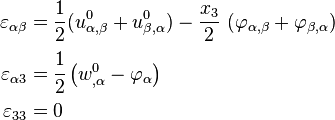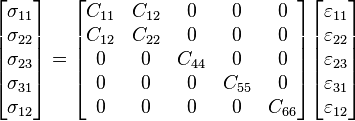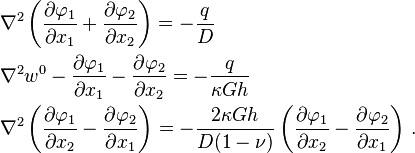Plate theory
| Continuum mechanics | ||||
|---|---|---|---|---|
 | ||||
|
Laws
|
||||

In continuum mechanics, plate theories are mathematical descriptions of the mechanics of flat plates that draws on the theory of beams. Plates are defined as plane structural elements with a small thickness compared to the planar dimensions.[1] The typical thickness to width ratio of a plate structure is less than 0.1. A plate theory takes advantage of this disparity in length scale to reduce the full three-dimensional solid mechanics problem to a two-dimensional problem. The aim of plate theory is to calculate the deformation and stresses in a plate subjected to loads.
Of the numerous plate theories that have been developed since the late 19th century, two are widely accepted and used in engineering. These are
- the Kirchhoff–Love theory of plates (classical plate theory)
- The Mindlin–Reissner theory of plates (first-order shear plate theory)
Kirchhoff–Love theory for thin plates
- Note: the Einstein summation convention of summing on repeated indices is used below.

The Kirchhoff–Love theory is an extension of Euler–Bernoulli beam theory to thin plates. The theory was developed in 1888 by Love[2] using assumptions proposed by Kirchhoff. It is assumed that a mid-surface plane can be used to represent the three-dimensional plate in two-dimensional form.
The following kinematic assumptions that are made in this theory:[3]
- straight lines normal to the mid-surface remain straight after deformation
- straight lines normal to the mid-surface remain normal to the mid-surface after deformation
- the thickness of the plate does not change during a deformation.
Displacement field
The Kirchhoff hypothesis implies that the displacement field has the form
where  and
and  are the Cartesian coordinates on the mid-surface of the undeformed plate,
are the Cartesian coordinates on the mid-surface of the undeformed plate,  is the coordinate for the thickness direction,
is the coordinate for the thickness direction,  are the in-plane displacements of the mid-surface, and
are the in-plane displacements of the mid-surface, and  is the displacement of the mid-surface in the
is the displacement of the mid-surface in the  direction.
direction.
If  are the angles of rotation of the normal to the mid-surface, then in the Kirchhoff–Love theory
are the angles of rotation of the normal to the mid-surface, then in the Kirchhoff–Love theory

 Displacement of the mid-surface (left) and of a normal (right) |
Strain-displacement relations
For the situation where the strains in the plate are infinitesimal and the rotations of the mid-surface normals are less than 10° the strains-displacement relations are
Therefore the only non-zero strains are in the in-plane directions.
If the rotations of the normals to the mid-surface are in the range of 10° to 15°, the strain-displacement relations can be approximated using the von Kármán strains. Then the kinematic assumptions of Kirchhoff-Love theory lead to the following strain-displacement relations
This theory is nonlinear because of the quadratic terms in the strain-displacement relations.
Equilibrium equations
The equilibrium equations for the plate can be derived from the principle of virtual work. For the situation where the strains and rotations of the plate are small, the equilibrium equations for an unloaded plate are given by
where the stress resultants and stress moment resultants are defined as
and the thickness of the plate is  . The quantities
. The quantities  are the stresses.
are the stresses.
If the plate is loaded by an external distributed load  that is normal to the mid-surface and directed in the positive
that is normal to the mid-surface and directed in the positive  direction, the principle of virtual work then leads to the equilibrium equations
direction, the principle of virtual work then leads to the equilibrium equations
For moderate rotations, the strain-displacement relations take the von Karman form and the equilibrium equations can be expressed as
Boundary conditions
The boundary conditions that are needed to solve the equilibrium equations of plate theory can be obtained from the boundary terms in the principle of virtual work.
For small strains and small rotations, the boundary conditions are
Note that the quantity  is an effective shear force.
is an effective shear force.
Stress–strain relations
The stress–strain relations for a linear elastic Kirchhoff plate are given by
Since  and
and  do not appear in the equilibrium equations it is implicitly assumed that these quantities do not have any effect on the momentum balance and are neglected.
do not appear in the equilibrium equations it is implicitly assumed that these quantities do not have any effect on the momentum balance and are neglected.
It is more convenient to work with the stress and moment results that enter the equilibrium equations. These are related to the displacements by
and
The extensional stiffnesses are the quantities
The bending stiffnesses (also called flexural rigidity) are the quantities
Isotropic and homogeneous Kirchhoff plate
For an isotropic and homogeneous plate, the stress–strain relations are
The moments corresponding to these stresses are
Pure bending
The displacements  and
and  are zero under pure bending conditions. For an isotropic, homogeneous plate under pure bending the governing equation is
are zero under pure bending conditions. For an isotropic, homogeneous plate under pure bending the governing equation is
In index notation,
In direct tensor notation, the governing equation is
Transverse loading
For a transversely loaded plate without axial deformations, the governing equation has the form
where
In index notation,
and in direct notation
In cylindrical coordinates  , the governing equation is
, the governing equation is
Orthotropic and homogeneous Kirchhoff plate
For an orthotropic plate
Therefore,
and
Transverse loading
The governing equation of an orthotropic Kirchhoff plate loaded transversely by a distributed load  per unit area is
per unit area is
where
Dynamics of thin Kirchhoff plates
The dynamic theory of plates determines the propagation of waves in the plates, and the study of standing waves and vibration modes.
Governing equations
The governing equations for the dynamics of a Kirchhoff–Love plate are
where, for a plate with density  ,
,
and
The figures below show some vibrational modes of a circular plate.
-

mode k = 0, p = 1
-

mode k = 1, p = 2
Isotropic plates
The governing equations simplify considerably for isotropic and homogeneous plates for which the in-plane deformations can be neglected and have the form
where  is the bending stiffness of the plate. For a uniform plate of thickness
is the bending stiffness of the plate. For a uniform plate of thickness  ,
,
In direct notation
Mindlin–Reissner theory for thick plates
- Note: the Einstein summation convention of summing on repeated indices is used below.
In the theory of thick plates, or theory of Raymond Mindlin[4] and Eric Reissner, the normal to the mid-surface remains straight but not necessarily perpendicular to the mid-surface. If  and
and  designate the angles which the mid-surface makes with the
designate the angles which the mid-surface makes with the  axis then
axis then
Then the Mindlin–Reissner hypothesis implies that
Strain-displacement relations
Depending on the amount of rotation of the plate normals two different approximations for the strains can be derived from the basic kinematic assumptions.
For small strains and small rotations the strain-displacement relations for Mindlin–Reissner plates are
The shear strain, and hence the shear stress, across the thickness of the plate is not neglected in this theory. However, the shear strain is constant across the thickness of the plate. This cannot be accurate since the shear stress is known to be parabolic even for simple plate geometries. To account for the inaccuracy in the shear strain, a shear correction factor ( ) is applied so that the correct amount of internal energy is predicted by the theory. Then
) is applied so that the correct amount of internal energy is predicted by the theory. Then
Equilibrium equations
The equilibrium equations have slightly different forms depending on the amount of bending expected in the plate. For the situation where the strains and rotations of the plate are smallthe equilibrium equations for a Mindlin–Reissner plate are
The resultant shear forces in the above equations are defined as
Boundary conditions
The boundary conditions are indicated by the boundary terms in the principle of virtual work.
If the only external force is a vertical force on the top surface of the plate, the boundary conditions are
Constitutive relations
The stress–strain relations for a linear elastic Mindlin–Reissner plate are given by
Since  does not appear in the equilibrium equations it is implicitly assumed that it do not have any effect on the momentum balance and is neglected. This assumption is also called the plane stress assumption. The remaining stress–strain relations for an orthotropic material, in matrix form, can be written as
does not appear in the equilibrium equations it is implicitly assumed that it do not have any effect on the momentum balance and is neglected. This assumption is also called the plane stress assumption. The remaining stress–strain relations for an orthotropic material, in matrix form, can be written as
Then,
and
For the shear terms
The extensional stiffnesses are the quantities
The bending stiffnesses are the quantities
Isotropic and homogeneous Mindlin–Reissner plates
For uniformly thick, homogeneous, and isotropic plates, the stress–strain relations in the plane of the plate are
where  is the Young's modulus,
is the Young's modulus,  is the Poisson's ratio, and
is the Poisson's ratio, and  are the in-plane strains. The through-the-thickness shear stresses and strains are related by
are the in-plane strains. The through-the-thickness shear stresses and strains are related by
where  is the shear modulus.
is the shear modulus.
Constitutive relations
The relations between the stress resultants and the generalized displacements for an isotropic Mindlin–Reissner plate are:
and
The bending rigidity is defined as the quantity
For a plate of thickness  , the bending rigidity has the form
, the bending rigidity has the form
where h=H/2
Governing equations
If we ignore the in-plane extension of the plate, the governing equations are
In terms of the generalized deformations  , the three governing equations are
, the three governing equations are
The boundary conditions along the edges of a rectangular plate are
Reissner–Stein theory for isotropic cantilever plates
In general, exact solutions for cantilever plates using plate theory are quite involved and few exact solutions can be found in the literature. Reissner and Stein[5] provide a simplified theory for cantilever plates that is an improvement over older theories such as Saint-Venant plate theory.
The Reissner-Stein theory assumes a transverse displacement field of the form
The governing equations for the plate then reduce to two coupled ordinary differential equations:
where
At  , since the beam is clamped, the boundary conditions are
, since the beam is clamped, the boundary conditions are
The boundary conditions at  are
are
where

Derivation of Reissner–Stein cantilever plate equations The strain energy of bending of a thin rectangular plate of uniform thickness  is given by
is given by
where
 is the transverse displacement,
is the transverse displacement,  is the length,
is the length,  is the width,
is the width,  is the Poisson's
ratio,
is the Poisson's
ratio,  is the Young's modulus, and
is the Young's modulus, andThe potential energy of transverse loads
 (per unit length) is
(per unit length) isThe potential energy of in-plane loads
 (per unit width) is
(per unit width) isThe potential energy of tip forces
 (per unit width), and bending moments
(per unit width), and bending moments  and
and  (per unit width) is
(per unit width) isA balance of energy requires that the total energy is
With the Reissener–Stein assumption for the displacement, we have
and
Taking the first variation of
 with respect to
with respect to  and
setting it to zero gives us the Euler equations
and
setting it to zero gives us the Euler equationsand
where
Since the beam is clamped at
 , we have
, we haveThe boundary conditions at
 can be found by integration by parts:
can be found by integration by parts:where
References
- ↑ Timoshenko, S. and Woinowsky-Krieger, S. "Theory of plates and shells". McGraw–Hill New York, 1959.
- ↑ A. E. H. Love, On the small free vibrations and deformations of elastic shells, Philosophical trans. of the Royal Society (London), 1888, Vol. série A, N° 17 p. 491–549.
- ↑ Reddy, J. N., 2007, Theory and analysis of elastic plates and shells, CRC Press, Taylor and Francis.
- ↑ R. D. Mindlin, Influence of rotatory inertia and shear on flexural motions of isotropic, elastic plates, Journal of Applied Mechanics, 1951, Vol. 18 p. 31–38.
- ↑ E. Reissner and M. Stein. Torsion and transverse bending of cantilever plates. Technical Note 2369, National Advisory Committee for Aeronautics,Washington, 1951.
See also
- Bending of plates
- Vibration of plates
- Infinitesimal strain theory
- Membrane theory of shells
- Finite strain theory
- Stress (mechanics)
- Stress resultants
- Linear elasticity
- Bending
- Föppl–von Kármán equations
- Euler–Bernoulli beam equation
- Timoshenko beam theory






![\begin{align}
N_{\alpha\beta,\alpha} & = 0 \\
M_{\alpha\beta,\alpha\beta} + [N_{\alpha\beta}~w^0_{,\beta}]_{,\alpha} - q & = 0
\end{align}](../I/m/b0540d0fff760e65355373cbb0cf25f8.png)















![\frac{1}{r}\cfrac{d }{d r}\left[r \cfrac{d }{d r}\left\{\frac{1}{r}\cfrac{d }{d r}\left(r \cfrac{d w}{d r}\right)\right\}\right] = - \frac{q}{D}\,.](../I/m/06fb2af0b5690fed73d532b7e5d10e27.png)



































![\begin{align}
& bD\cfrac{d^3 w_x}{d x^3} + n_1(x)\cfrac{d w_x}{d x} + n_2(x)\cfrac{d \theta_x}{d x} + q_{x1} = 0 \\
& \frac{b^3D}{12}\cfrac{d^3 \theta_x}{d x^3} + \left[n_3(x) -2bD(1-\nu)\right]\cfrac{d \theta_x}{d x}
+ n_2(x)\cfrac{d w_x}{d x} + t = 0 \\
& bD\cfrac{d^2 w_x}{d x^2} + m_1 = 0 \quad,\quad \frac{b^3D}{12}\cfrac{d^2 \theta_x}{d x^2} + m_2 = 0
\end{align}](../I/m/19bf7f6399a56fd48e62e871c4957a49.png)
![U = \frac{1}{2} \int_0^a \int_{-b/2}^{b/2}D\left\{\left(\frac{\partial^2 w}{\partial x^2} + \frac{\partial^2 w}{\partial y^2}\right)^2 +
2(1-\nu)\left[\left(\frac{\partial^2 w}{\partial x \partial y}\right)^2 - \frac{\partial^2 w}{\partial x^2}\frac{\partial^2 w}{\partial y^2}\right]
\right\}\text{d}x\text{d}y](../I/m/57185e87d5e6ea9379d5b7f111da7fd1.png)





![U = \int_0^a\frac{bD}{24}\left[12\left(\cfrac{d^2 w_x}{d x^2}\right)^2 +
b^2\left(\cfrac{d^2 \theta_x}{d x^2}\right)^2 + 24(1-\nu)\left(\cfrac{d \theta_x}{d x}\right)^2\right]\,\text{d}x\,,](../I/m/56a775cc5ae02ff115831ef36abc2f18.png)
![P_q = \int_0^a\left[\left(\int_{-b/2}^{b/2}q(x,y)\,\text{d}y\right)w_x + \left(\int_{-b/2}^{b/2}yq(x,y)\,\text{d}y\right)\theta_x\right]\,dx \,,](../I/m/ccaf09e5ed81cab1f59f9e81b3438b31.png)
![\begin{align}
P_n & = \frac{1}{2}\int_0^a\left[\left(\int_{-b/2}^{b/2}n_x(x,y)\,\text{d}y\right)\left(\cfrac{d w_x}{d x}\right)^2 +
\left(\int_{-b/2}^{b/2}y n_x(x,y)\,\text{d}y\right)\cfrac{d w_x}{d x}\,\cfrac{d \theta_x}{d x} \right.\\
& \left. \qquad\qquad +\left(\int_{-b/2}^{b/2}y^2 n_x(x,y)\,\text{d}y\right)\left(\cfrac{d \theta_x}{d x}\right)^2\right]\text{d}x\,,
\end{align}](../I/m/a19ca309263af9ec52d1501d5f805fca.png)
![\begin{align}
P_t & = \left(\int_{-b/2}^{b/2}q_x(y)\,\text{d}y\right)w_x -
\left(\int_{-b/2}^{b/2}m_x(y)\,\text{d}y\right)\cfrac{d w_x}{d x} +
\left[\int_{-b/2}^{b/2}\left(y q_x(y) + m_{xy}(y)\right)\,\text{d}y\right]\theta_x \\
& \qquad \qquad -\left(\int_{-b/2}^{b/2}y m_x(y)\,\text{d}y\right)\cfrac{d \theta_x}{d x} \,.
\end{align}](../I/m/498b278f6d9d161be05e81e0f39cfb55.png)



